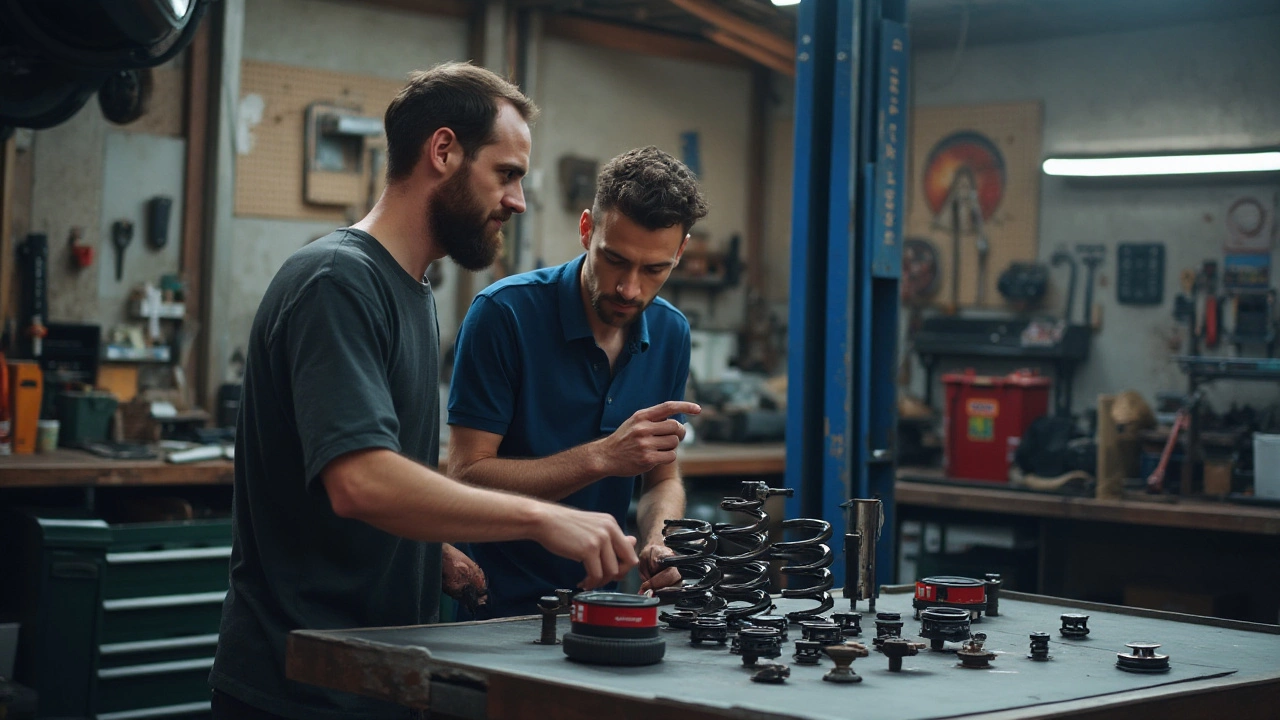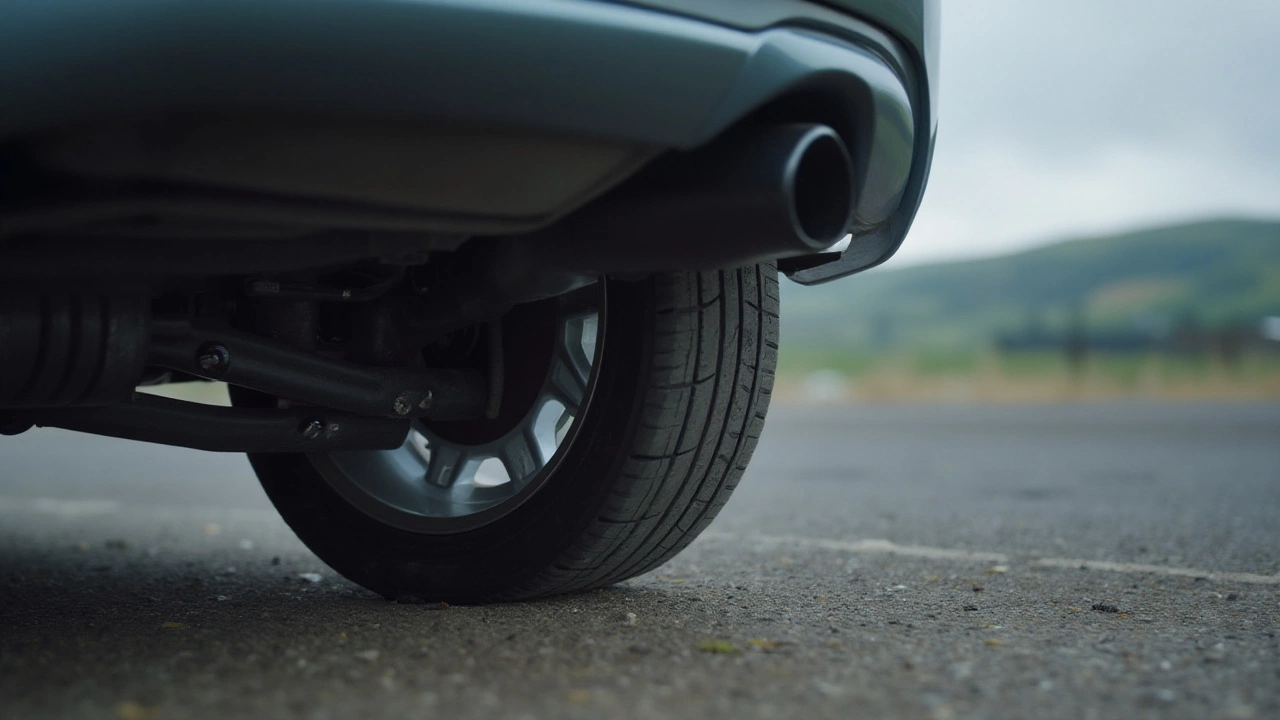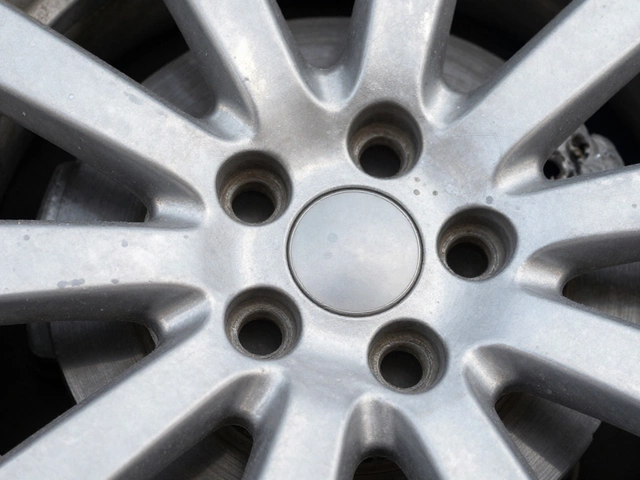Car enthusiasts are often drawn to the sleek look of a car seated closer to the ground, thanks to lowering springs. Whether it's for improved handling or the visual appeal, swapping out standard springs is a common modification.
But there's a dilemma lurking in the shadows: how do these lowering springs impact other parts, like your vehicle’s struts? The answer isn’t as simple as it seems because altering one part of your car's suspension can ripple through the entire system.
Diving into the details, we will explore what happens to the struts when lowering springs come into play. By shedding light on common myths and offering practical tips, this article aims to equip you with useful insight into maintaining a well-balanced suspension setup.
- Understanding Lowering Springs
- Function of Struts in Your Car
- Impact of Lowering Springs on Struts
- Common Myths and Misconceptions
- Tips for Maintaining Your Suspension
- When to Seek Professional Advice
Understanding Lowering Springs
When it comes to modifying the suspension of a car, one of the most favored options among enthusiasts is the installation of lowering springs. These springs are not just about enhancing aesthetics by reducing the vehicle’s ride height to create an aggressive stance. They are crafted to improve handling, giving your car a lower center of gravity which can lead to sharper turns and less body roll during those fast-paced cornering sessions. But how do these seemingly simple coils accomplish this feat? It starts with the material they are made from, often high-tensile steel, which allows them to endure the compressive forces without losing their elasticity swiftly.
Delving deeper, lowering springs work by compressing the suspension system closer to the ground. This compression not only reduces the center of gravity but also affects the suspension geometry, which can change the handling characteristics of your car. For example, reducing the ride height can lead to increased camber, affecting tire contact with the road. The design and rate of these springs are fine-tuned for specific handling traits. A stiffer spring rate is common, allowing less suspension travel, thus providing a tighter, more controlled driving experience. Some might argue this can result in a harsher ride over uneven surfaces, but the trade-offs often weigh favorably for many seeking performance enhancements.
Interestingly, lowering springs are typically matched to specific vehicles, considering the original weight distribution and suspension setup. This ensures that when implemented, the balance between ride comfort and performance is maintained as best as possible. A well-engineered lowering spring can drastically improve vehicle maneuverability without severely impacting daily comfort. In the words of renowned automotive expert and author, Doug DeMuro,
"Lowering springs provide a noticeable difference in handling, but it’s vital to understand how they interact with overall vehicle dynamics."This makes it clear that selecting the right springs isn't just about preference but also about compatibility with other suspension components such as the struts.
To provide a glimpse into how prevalent and influential lowering springs have become, consider recent data from the automotive aftermarket industry. A survey revealed that nearly 30% of aftermarket suspension modifications include lowering springs, indicating their popularity among drivers who seek both visual appeal and a performance edge. Although lowering a vehicle is a personal choice often inspired by the desire for improved road handling and visual aesthetics, it’s crucial to understand the implications this change has on other components within the suspension system. This understanding helps in maintaining not just performance but safety on the road as well. Whether aiming for track performance or just a head-turning drive down the boulevard, knowing about the material, construction, and influence of these springs is quintessential for any car aficionado.
Function of Struts in Your Car
Struts are an integral component of your car's suspension system, providing structural support and stability to ensure a smooth and balanced ride. Think of them as a key structural part that combines the functions of shock absorbers and several suspension parts into one compact assembly. The primary role of struts is to absorb the shocks from bumps and dips on the road, which they do by compressing and releasing. This dampening action helps keep your tires in constant contact with the road surface, promoting traction and making your driving experience both safer and more comfortable.
Not only do struts act as shock absorbers, but they also provide support to the suspension springs, which play a crucial role in managing the overall weight distribution of your vehicle. By maintaining proper alignment of your wheels, struts help in reducing tire wear and improving fuel efficiency. Their position at the top of the suspension system means they are also essential in maintaining the correct ride height, which influences aerodynamics and fuel economy. It's worth noting that worn-out struts can significantly compromise vehicle handling and braking efficiency, increasing the risk of road accidents.
According to Car and Driver, "Properly functioning struts are critical for distributing force evenly across the tires during braking, leading to fewer unpredictable movements and safer driving conditions.”
Inside each strut lies a powerful coil spring. Together, both components create a framework that ensures ride quality without forsaking control. Whether you're navigating city streets or tackling winding country roads, struts work tirelessly behind the scenes to provide a driving experience that's deliberately seamless.
One important aspect of struts is their role in connecting multiple suspension and steering elements. As part of the strut assembly, wheel alignment and steering angles align, contributing significantly to how your car handles curves and turns. Given their importance, any alteration to the suspension, such as installing lowering springs, must be carefully considered, as it directly affects the stress placed on the struts. When replacing or adjusting components, it’s always a good practice to consult with a professional mechanic to assess potential impacts on your struts and the overall safety of your car.
The lifecycle of struts can vary greatly depending on driving conditions and vehicle usage. Nevertheless, as a general recommendation, many manufacturers suggest inspecting them every 50,000 miles. In some cases, early signs such as excess bouncing or nosediving during braking may indicate that it's time for replacement. Recognizing these indicators early can preempt further damage to other components, saving time and money in the long run.

Impact of Lowering Springs on Struts
Lowering springs are a favorite modification among car lovers, offering not just a more aggressive stance but also improved handling characteristics due to the lowered center of gravity. However, this appealing change in dynamics isn't without its challenges, particularly for the struts. Struts play a critical role in your car's suspension system by providing structural support for the suspension and absorbing road shocks. When you introduce lowering springs, you invariably alter the natural resting position and travel of the strut. This can lead to increased stress and a potential reduction in the lifespan of these components. While the visual aesthetics are undeniable, the trade-offs need careful consideration, especially regarding the vehicle maintenance budget.
One of the primary concerns with lowering springs is the potential for faster wear and tear on struts. This is because lowering springs typically have a stiffer spring rate compared to stock springs. The increased stiffness can put additional pressure on your struts as they strive to maintain a smooth ride over potholes and uneven surfaces. This can even lead to premature failure if the components are not compatible or engineered to work together. Notably, professional racers often have bespoke suspension setups that address these issues, but for street vehicles, it requires vigilance and sometimes compromises on comfort to ensure longevity.
"Lowered cars can boost performance on the track but may require sacrifices in everyday drivability," a well-known automotive engineer remarked during a recent interview with an enthusiast magazine.
Another important factor is the change in the suspension geometry. With lowering springs, the struts might not always operate within their optimal range due to altered angles, potentially impacting handling and safety. This risk is particularly pronounced in vehicle models that do not offer aftermarket adjustable struts aimed at maintaining the proper suspension alignment. Additionally, the change in geometry might require adjustments to camber angles, which can also contribute to uneven tire wear if not correctly aligned. Therefore, if you've decided to go down this path, it's crucial to monitor tire condition regularly to avoid unexpected expenses.
Despite these challenges, many drivers maintain that the advantages of lowering springs outweigh the disadvantages, especially when adjusted sensibly. By pairing lowering springs with struts specifically designed for lower ride heights, enthusiasts can mitigate many potential issues. It's also advisable to opt for progressive spring designs, which offer a balanced compromise between comfort and performance. For those dedicated to achieving an optimum setup, engaging with professionals who understand the nuances of suspension dynamics can be beneficial. Their expertise can guide the choice of components that work harmoniously, preserving not just the looks but also the safety and reliability of the vehicle.
Common Myths and Misconceptions
Many car enthusiasts often dive headfirst into modifications without fully understanding the impact of their choices, especially concerning the use of lowering springs. It's a common belief that just swapping the springs is a straightforward upgrade, accessible to anyone with a good toolkit and a few hours to spare. Unfortunately, this isn't always true. One myth that's particularly stubborn is the idea that lowering springs will automatically enhance a car’s performance across all parameters. While they do improve cornering by lowering the vehicle's center of gravity and minimizing body roll, they can also introduce complications if not paired with the right components, like compatible struts.
Another widespread misconception is that any suspension modification is detrimental to vehicle components. In reality, while lowering a car does put additional stress on various elements of the suspension, proper installation and selecting the correct parts for your car's make and model can mitigate these effects. An often-overlooked fact is that struts, in particular, are designed differently for various suspension setups. Using standard struts with lowering springs might not yield the ideal ride quality or might wear out the struts faster due to the new tension dynamics.
Some experts have pointed out that the key lies in understanding how struts work in conjunction with springs. As mentioned by auto engineer Mike McCarthy, “Modification isn’t bad, but tailoring those modifications to your vehicle and driving needs is what’s essential.”
“Modification isn’t bad, but tailoring those modifications to your vehicle and driving needs is what’s essential.” - Mike McCarthy, Auto Engineer
This brings us to the topic of ride comfort. Critics often declare that lowering springs make for a spine-jarring experience over any bump. While it’s true that suspension becomes stiffer, sacrificing some plushness for performance, modern lowering springs have evolved. Many are engineered to offer a compromise between aggressive looks and everyday comfort, when correctly matched with struts designed for lowered setups. Always checking for quality brands and understanding the specifications of each component is paramount.
Another nugget of advice emerges from the misconception that all cars are suited for aggressive lowering without adverse effects. Each vehicle is unique, and so are its suspensions. Lowering exaggeratedly can lead to issues with alignment, further wear on tires, or even problems with the car's undercarriage scraping on uneven roads. To get the best of both worlds, a balance is crucial. A slight drop, complemented with aftermarket adjustable struts, often proves to be the sweet spot for both performance and longevity.
Ultimately, while myths and misconceptions about lowering springs abound, arming oneself with correct information helps in making informed decisions. If uncertainty remains, consulting a professional or a seasoned enthusiast community is always a wise move. They can share insights from their experiences and steer you clear of common pitfalls, helping you achieve the perfect blend of aesthetics and performance without compromising the vehicle's integrity.

Tips for Maintaining Your Suspension
When it comes to your vehicle’s suspension, keeping everything running smoothly requires some attention and proactive care. It doesn’t just ensure safety and performance; it also prolongs the life of both the lowering springs and struts. Regular checks and proper maintenance are simple yet crucial steps in avoiding costly repairs or replacements down the line. The suspension is like a complex dance partner; every move you make can affect the balance and rhythm of the entire system.
Regular Inspections and Alignments
Conducting regular inspections is an essential practice for every car owner, and it's especially vital if you've opted for modifications like lowering springs. Inspect your tires for uneven wear – a common signal that your alignment may be out. An off-kilter alignment can lead to more stress on the struts and cause premature wear. Vehicle experts often suggest that a routine alignment check every 12,000 to 15,000 miles can help keep things in check. Don’t skip these alignments, as they offer a chance to address potential issues before they become serious problems.
Use the Right Replacement Parts
"Investing in high-quality replacement parts can make all the difference," says Jamie Lee, a seasoned mechanic. "Skimping on things like struts when using lowering springs is a recipe for trouble."
Selecting components that are compatible and specifically designed for your setup is key. Using manufacturer-approved parts ensures that the modifications don't lead to unexpected hiccups in your suspension system. High-performance struts, for instance, might be an ideal match for lowering springs, providing the support and durability needed for the altered specifications.
Driving with Care
While it might be tempting to push your newly modified ride to its limits, driving with an awareness of your suspension’s new dynamics is crucial. Lowering springs can change the feel of your car, altering responsiveness. Fast cornering or hitting bumps at high speed can exert additional strain on your struts. Practice smooth acceleration and deceleration, as this reduces the inertia load on the suspension. Over time, gentle driving habits can make a significant difference in vehicle longevity.
Keep an Eye on Fluid Levels
Your suspension also involves hydraulic fluids, which exemplify the unsung heroes working behind the scenes. Ensure that liquid levels are regularly checked, as they play a crucial role in cushioning the ride and aiding the performance of struts. Low or leaking fluid can trigger various suspension issues, affecting the efficiency of the struts. Ignoring these can lead to a symptomatic chain reaction: first, the impact on road handling and eventually, the wear and tear on other components.
Consulting Experts
Sometimes, keeping the expertise of professionals in the loop can provide additional reassurance. Whether it’s seeking advice on alignment services or ensuring you’re using the right replacement parts, professionals bring a wealth of knowledge and experience. They offer insights that consider the full picture of how all parts interact—vital for achieving that harmonious balance your lowering springs and struts strive for. Make it a habit to consult an expert when you notice a change in the vehicle’s handling, noises, or other warning signs.
When to Seek Professional Advice
Understanding when it's time to consult a professional can save you both time and money while ensuring that your vehicle operates safely. Lowering your car with lowering springs might seem straightforward to some, but it involves a complex interplay between various components of your suspension system, including the struts. If you notice unusual behaviors in your car, like excessive bouncing or uneven tire wear, these could be tell-tale signs that professional intervention is needed. Such symptoms often indicate that the struts may not be handling the altered suspension dynamics well, possibly leading to premature wear or even failure.
Imagine cruising down the highway and feeling like you’re on a trampoline, or seeing your tires exhibit odd wear patterns that's never noticed before. These are more than mere inconveniences; they signal that your car's balance and performance are at stake. At this point, it's crucial to take your vehicle to a suspension expert who can diagnose the issue accurately. They might recommend high-performance struts designed to work efficiently with lowering springs, preventing further complications. A skilled professional can also analyze whether the lowering has affected the camber and toe angles, aspects that can easily slip under the radar but significantly affect handling and safety.
One might think, “It can’t be that difficult to adjust a couple of springs!” But here lies the risk: a simple DIY mentality might lead to overlooking fine-tuned adjustments necessary for peak suspension performance. Professionals rely on sophisticated tools and expertise, providing a level of accuracy you can't achieve with a basic toolkit. As Jamie Kitman from Car and Driver once noted,
“There's an artistry and science in aligning and tuning a car's suspension that's rarely appreciated until it's disrupted.”Thus, for the average car owner, admitting when expertise beyond Google searches and YouTube tutorials is required can save a lot of pain, and money down the road.
An experienced technician can ensure that your new set-up aligns with manufacturer specifications or provide customized recommendations if you're driving a vehicle with specific performance requirements. They may also address overlooked issues like the necessity for a camber kit or spacers to ensure optimal strut alignment. By seeking advice when things seem amiss, you'll not only keep your ride smooth and responsive but also lengthen the lifespan of your struts and other vital components.
To bring it all together, whether prompted by new noises, handling quirks, or simply preventive maintenance, seeking out professional insight is a smart move when it comes to lowering springs and struts. Driving is supposed to be enjoyable, and entrusting certain tasks to those with specialized knowledge is an investment in both performance and driving peace of mind. Consider professional advice as a safeguard, protecting you from potential missteps that could compromise safety or lead to costly repairs.






